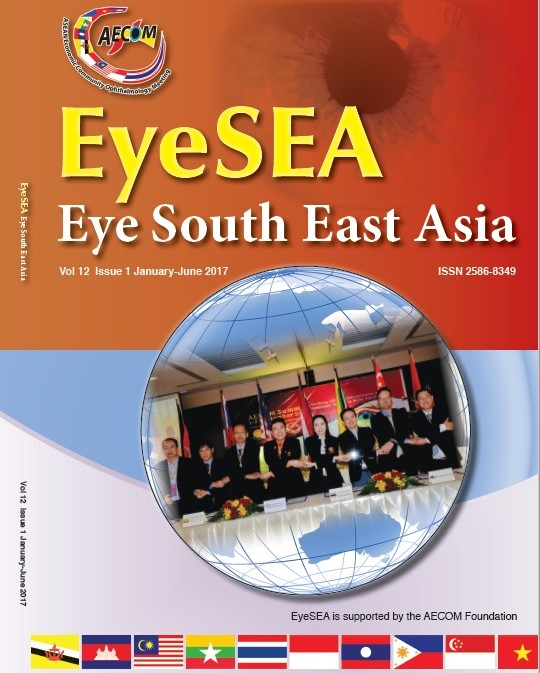Choroidal Melanoma: Experience From A Tertiary Referral Centre In Malaysia
Main Article Content
Abstract
Background: Choroidal melanoma is known as the most common primary intraocular malignancy in adults. Nevertheless, it is more commonly found in Caucasians and rarely found in Malaysian population.
Objective: We present eight cases of choroidal melanoma referred to Hospital Selayang, a tertiary centre for medical retinal cases, from 2012 to 2016.
Method: Retrospective case series.
Results: There were six females and two males with a mean age was 53.9 years old. Five patients were Chinese and three were Malay. The presenting complaints included visual field defect (n=3), distorted vision (n=2), photopsiae (n=2) and decreased vision (n=1). The tumour thickness ranged from 3.00 to 13.94 mm (mean=8.93mm). Two cases had exudative retinal detachment while the remaining had adjacent sub-retinal fluid. Three patients had undergone globe-preserving therapy (plaque brachytherapy and stereotactic radiotherapy) while the remaining had undergone enucleation or exenteration. The histopathological examinations showed three cases of spindle B cells, one with epitheliod cells and one with mixed features. All patients were well under regular follow-up and there was no reported recurrences or distant metastasis till date.
Conclusions: Although choroidal melanoma is very rare among Malaysian population, it is a crucial diagnosis to make in view of its metastatic risks. Early presentation and diagnosis of choroidal melanoma is significant to save lives.
Article Details
References
Parul Singh and Abhishek Singh. Choroidal melanoma. Oman Journal of Ophthalmology. 2012 Jan-Apr; 5 (1): 3-9.
Shields CL, Furuta M, Berman EL, Zahler JD, Hoberman DM, Dinh DH et al. Choroidal Nevus Transformation Into MelanomaAnalysis of 2514 Consecutive Cases. Arch Ophthalmol. 2009; 127(8):981-987.
Shah CP, Weis E, Lajous M et al. Intermittent and chronic ultraviolet light exposure and uveal melanoma. A meta-analysis. Ophthalmology 2005; 112: 1599-1607.
Gunduz K, Shields CL, Shields JA et al. Radiation retinopathy following plaque radiotherapy of posterior uveal melanoma. Arch Ophthalmol 1999; 117: 609-614.
Sagoo MS, Shields CL, Emrich J, Mashayekhi A, Komarnicky L and Shields JA. Plaque radiotheraphy for juxtapapillary choroidal melanoma; treatment complications and visual outcomes in 650 consecutive cases. JAMA Ophthalmol. 2014 Jun; 132 (6): 697-702.
The Collaborative Ocular Melanoma Study Group. The Collaborative Ocular Melanoma Study (COMS) randomized trial of preenucleation radiation of large choroidal melanoma II: initial mortality findgins. COMS report no. 10. Am J Ophthalmol 1998; 126:779-796.
Collaborative Ocular Melanoma Study (COMS) Group. The COMS randomized trial of iodine 125 bracytherapy for choroidal melanoma V. Twelve-year mortality rates and prognostic factors: COMS report no. 28. Arch Ophthalmol 2006; 124:1684-1693.
Shields CL, Manalac J, Das C, Ferguson K and Shields JA. Choroidal melanoma: clinical features, classification, and top 10 pseudomelanomas. Current Opinion Ophthalmology. 2014; 25; 177-185.
Shields CL, Furata M, Thangappan A et al. Metastasis of uveal melanoma milimeter-by-milimeter in 8033 consecutive eyes. Arch Ophthalmol 2009; 127:989-998.

